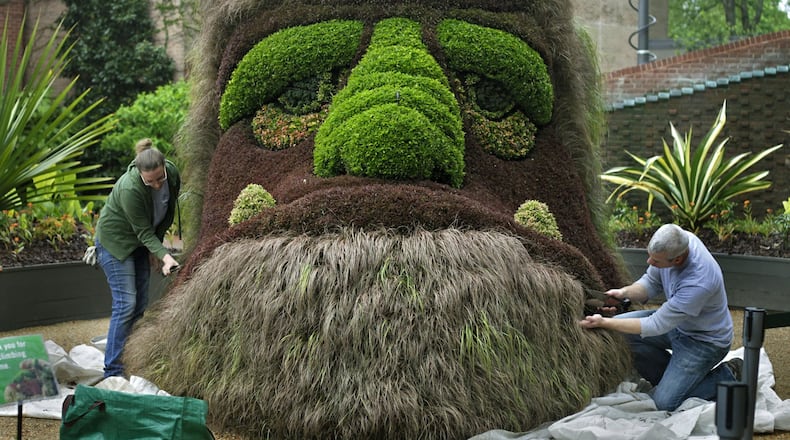EXHIBIT PREVIEW
“Imaginary Worlds: Plants Larger Than Life”
Opening May 4 at the Atlanta Botanical Garden. 9 a.m.-7 p.m. Tuesdays-Sundays (until 10 p.m. Thursdays). Through October. $18.95, $12.95 ages 3-12, free under 3. 1345 Piedmont Ave. N.E., Atlanta. 404-876-5859.
BY THE NUMBERS
19 — sculptures in nine settings
118,000 — plants covering the sculptures
7 — temporary workers who will assist garden's horticulture staff in maintaining the plants
28 tons — weight of Earth Goddess, assembled from 23 sections
$2 million — cost to present the exhibit
countless — Chia Pets for sale in Botanical Garden gift shop
“Imaginary Worlds: Plants Larger Than Life” doesn’t officially open until Saturday at the Atlanta Botanical Garden, but early, rather spontaneous reviews of the exhibition have been encouraging.
A week ago, as many of the 19 sculptures festooned with 118,000 living plants were still being installed, excited guests moved about the 30-acre garden trying to discover each of the fanciful creations. No one seemed deterred from the task when facing the unfinished, headless giant cobra or by the workers standing atop the dreamy noggin of the 25-foot-tall Earth Goddess, preparing for a crane to hoist her final sections into place.
A gaggle of Red Hat Society ladies whipped out tiny digital cameras and cellphones to click images of a shaggy ogre who looked like an escapee from “Shrek.” Down the sidewalk, schoolkids jumped for joy as they came upon a pair of dancing fish that spouted water while spinning circles in Howell Fountain.
“Whoa!” they shouted, as if they’d uncovered the world’s largest Chia Pets. “Awesome!”
Mary Pat Matheson smiled sunnily. The garden’s president and CEO for nearly a decade has cultivated the idea of the Midtown green spot as an “outdoor museum,” a prime setting for exhibitions and other cultural programming.
She seeded that notion with a 2004 show of Dale Chihuly glass sculptures that attracted 425,000 visitors in eight months, beginning a string of strong-drawing warm-weather exhibits amid the pristine plantings. And last winter, a season when the garden used to ease into a hibernation interrupted by few visitors, it drew 168,000 in its second year of theholiday light show “Garden Lights, Holiday Nights.”
So Matheson was on it when tipped by a Canadian colleague a couple of years ago that International Mosaiculture of Montreal, a nonprofit group that has staged sprawling competitions around the world in this curious art and science, was interested in creating exhibitions scaled for smaller sites such as the Atlanta Botanical Garden.
“I said, ‘I want first dibs, I want to be the first to do this exhibition,’ ” Matheson recalled. “We’ve never done a summer exhibit that’s plant-centric, so this is particularly exciting to us, to show how you can take art and sculpture and enhance it with plantings.”
Thus, the Midtown attraction beside Piedmont Park will host the first major mosaiculture show in the U.S.
Even though few in these parts know what mosaiculture is exactly.
And even though Matheson and her development staff had to raise $2 million, easily the garden’s biggest exhibit budget to date.
But then everything about “Imaginary Worlds: Plants Larger Than Life” is big.
The sculptures were transported by 15 refrigerated trucks during a 20-hour drive from Montreal to Atlanta. Earth Goddess alone commanded four tractor-trailers.
Also along for the ride, in addition to the makings of the cobras and ogre, were sections for six rabbits, two butterflies, a unicorn, a dog and a trio of rotund berries on skinny legs that look like they might be kin to those singing California raisins.
Each is made up of carefully pruned annuals planted into soil-and-sphagnum moss-filled netting that blankets the steel forms. Different types of plants are juxtaposed to create texture and patterns that define the look of each creation. For instance, Earth Goddess consists of more than 40,000 plants, including potato vine, sedum, fan flower, lantana, Joseph’s coat and petunias.
Built-in irrigation systems are hidden inside it and other large pieces, keeping them watered daily. Smaller ones simply have to be sprayed with a hose.
The roots of modern mosaiculture extend to 16th-century Europe, where wealthy landowners commissioned elaborate three-dimensional gardens or “embroidery beds.” The art later evolved into more sculptural and three-dimensional forms. The term mosaiculture was first employed in France in the 1860s.
To make it a familiar one around Atlanta, Matheson knows, will be a challenge. A billboard starring a 3D cobra (made of fiberglass and plastic, not plants) will dangle over the Downtown Connector at 14th Street. Marketing strong on visuals is cranking up, as well.
But beyond all that, Matheson said that strong word of mouth will determine the show’s success, pointing out that Montreal Botanical Garden drew 700,000 in 2000 for the first mosaiculture competition on the power of such buzz.
“You can look at that and say it’s one of those magnetic exhibits,” she said, allowing that her “fantasy goal” for Atlanta is 300,000.
Even if "Imaginary Worlds" scores an overwhelming success, it won't be extended. By the end of the six-month run in October, the annuals will be getting played out.
But the Earth Goddess will remain at the edge of the Cascades Garden, where water streams out of her palm into the pool below, for several more years. (Matheson doesn’t like to call anything in the garden “permanent.”)
Earth Goddess, which the garden bought, will be replanted next spring, and Matheson hopes she will become an icon at the attraction. But before that she’ll be transformed into the Ice Queen for the next edition of “Garden Lights, Holiday Nights.”
About the Author
Keep Reading
The Latest
Featured


